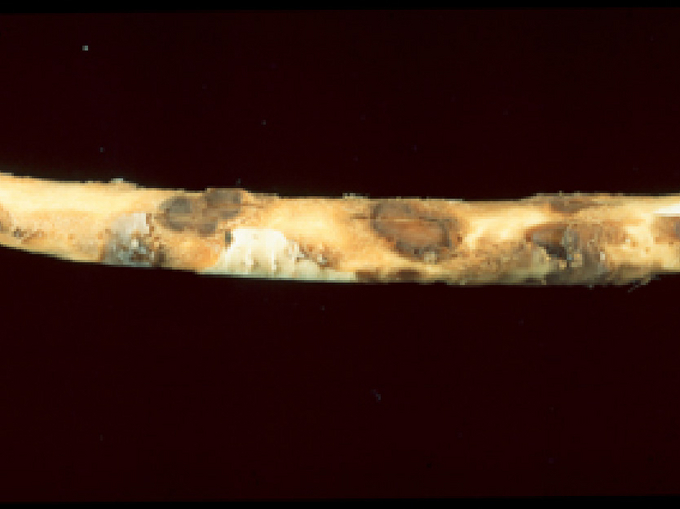Rhizoctonia solani on horseradish
Rhizoctonia solani
Profile
The fungus Rhizoctonia solani attacks both the main roots, which are later harvested and marketed as the so-called horseradish stalks, and the secondary roots (fechsern) of the horseradish plants. This results in yield losses on the one hand and the spread of the fungus on the other, since the secondary roots are the planting material for the next year's crop.
Damage symptoms
Roundish to oval sunken spots can be seen on the cuttings (fechers), usually 0.5 to 2 cm in size. They are darker in color than the surrounding tissue and eventually turn dark brown. At higher moisture levels, Rhizoctonia solani forms a whitish mesh of fungal filaments on infested areas. Sunken, brown discolored, roundish to oval spots, which can sometimes be cracked, are also visible on the finished canes. A whitish fungal thread network is also formed on these under more humid conditions. In many cases, however, the infested areas look cancerously overgrown. These symptoms occur when the tissue of the stalks becomes soft rotten due to an infestation and is rubbed off the stalks during harvesting. The horseradish stalk is then no longer beautifully smooth, but in many cases scarred. In the case of more severe infestation by Rhizoctonia solani, dark survival structures of the fungus, known as sclerotia, can also be seen in those areas where abundant fungal filaments have been formed. The infestation may also occur on the head of the canes.


Propagation and transmission
A whitish fungal thread network (= mycelium) can be seen at the infested areas. However, no spore carriers and spores are formed on these fungal threads. The fungus therefore spreads at this stage only by the steady growth of its fungal filaments. Rhizoctonia solani survives by means of mycelium or small, brown sclerotia in the soil or on infected plant debris.
The optimum temperature for the development of this fungus is between 25 and 30 °C, but it still grows below 10 °C. The fungus occurs in various adapted pathotypes. Infections occur by direct penetration of plant tissue. Infestation occurs preferentially at low pH, temperatures above 16 °C, persistent high humidity, and high humus content. No infections take place below 9 °C. At 9 °C, the incubation period lasts eleven to 15 days, at 20 °C less than three days.
Last updated: 17.01.2022
automatically translated